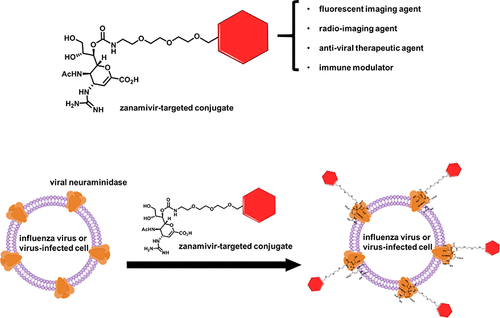当前位置:
X-MOL 学术
›
Bioconjugate Chem.
›
论文详情
Our official English website, www.x-mol.net, welcomes your
feedback! (Note: you will need to create a separate account there.)
Design of Neuraminidase-Targeted Imaging and Therapeutic Agents for the Diagnosis and Treatment of Influenza Virus Infections
Bioconjugate Chemistry ( IF 4.0 ) Pub Date : 2021-06-23 , DOI: 10.1021/acs.bioconjchem.1c00255 Xin Liu 1, 2 , Weichuan Luo 1, 2 , Boning Zhang 1, 2 , Yong Gu Lee 1, 2 , Imrul Shahriar 1, 2 , Madduri Srinivasarao 1, 2 , Philip S Low 1, 2
Bioconjugate Chemistry ( IF 4.0 ) Pub Date : 2021-06-23 , DOI: 10.1021/acs.bioconjchem.1c00255 Xin Liu 1, 2 , Weichuan Luo 1, 2 , Boning Zhang 1, 2 , Yong Gu Lee 1, 2 , Imrul Shahriar 1, 2 , Madduri Srinivasarao 1, 2 , Philip S Low 1, 2
Affiliation

|
The last step in influenza virus replication involves the assembly of viral components on the infected cell’s plasma membrane followed by budding of intact virus from the host cell surface. Because viral neuraminidase and hemagglutinin are both inserted into the host cell’s membrane during this process, influenza virus-infected cells are distinguished from uninfected cells by the presence of viral neuraminidase and hemagglutinin on their cell surfaces. In an effort to exploit this difference in cell surface markers for development of diagnostic and therapeutic agents, we have modified an influenza neuraminidase inhibitor, zanamivir, for targeting of attached imaging and therapeutic agents selectively to influenza viruses and virus-infected cells. We have designed here a zanamivir-conjugated rhodamine dye that allows visual monitoring of binding, internalization, and intracellular trafficking of the fluorescence-labeled neuraminidase in virus-infected cells. We also synthesize a zanamivir-99mTc radioimaging conjugate that permits whole body imaging of the virus’s biodistribution and abundance in infected mice. Finally, we create both a zanamivir-targeted cytotoxic drug (i.e., zanamivir-tubulysin B) and a viral neuraminidase-targeted CAR T cell and demonstrate that they are both able to kill viral neuraminidase-expressing cells without damaging healthy cells. Taken together, these data suggest that the influenza virus neuraminidase inhibitor, zanamivir, can be exploited to improve the diagnosis, imaging, and treatment of influenza virus infections.
中文翻译:

用于流感病毒感染诊断和治疗的神经氨酸酶靶向成像和治疗药物的设计
流感病毒复制的最后一步包括在受感染细胞的质膜上组装病毒成分,然后从宿主细胞表面出芽完整的病毒。由于病毒神经氨酸酶和血凝素在此过程中均插入宿主细胞膜,流感病毒感染细胞与未感染细胞的区别在于其细胞表面存在病毒神经氨酸酶和血凝素。为了利用细胞表面标志物的这种差异来开发诊断和治疗剂,我们改进了流感神经氨酸酶抑制剂扎那米韦,用于选择性地将附着的成像和治疗剂靶向流感病毒和病毒感染的细胞。我们在这里设计了一种与扎那米韦结合的罗丹明染料,可以对结合进行目视监测,病毒感染细胞中荧光标记的神经氨酸酶的内化和细胞内运输。我们还合成了一种扎那米韦-99m Tc 放射成像偶联物,允许对受感染小鼠中病毒的生物分布和丰度进行全身成像。最后,我们创造了一种靶向扎那米韦的细胞毒性药物(即扎那米韦-微管溶素 B)和一种靶向病毒神经氨酸酶的 CAR T 细胞,并证明它们都能够杀死表达病毒神经氨酸酶的细胞而不损害健康细胞。总之,这些数据表明流感病毒神经氨酸酶抑制剂扎那米韦可用于改善流感病毒感染的诊断、成像和治疗。
更新日期:2021-08-19
中文翻译:

用于流感病毒感染诊断和治疗的神经氨酸酶靶向成像和治疗药物的设计
流感病毒复制的最后一步包括在受感染细胞的质膜上组装病毒成分,然后从宿主细胞表面出芽完整的病毒。由于病毒神经氨酸酶和血凝素在此过程中均插入宿主细胞膜,流感病毒感染细胞与未感染细胞的区别在于其细胞表面存在病毒神经氨酸酶和血凝素。为了利用细胞表面标志物的这种差异来开发诊断和治疗剂,我们改进了流感神经氨酸酶抑制剂扎那米韦,用于选择性地将附着的成像和治疗剂靶向流感病毒和病毒感染的细胞。我们在这里设计了一种与扎那米韦结合的罗丹明染料,可以对结合进行目视监测,病毒感染细胞中荧光标记的神经氨酸酶的内化和细胞内运输。我们还合成了一种扎那米韦-99m Tc 放射成像偶联物,允许对受感染小鼠中病毒的生物分布和丰度进行全身成像。最后,我们创造了一种靶向扎那米韦的细胞毒性药物(即扎那米韦-微管溶素 B)和一种靶向病毒神经氨酸酶的 CAR T 细胞,并证明它们都能够杀死表达病毒神经氨酸酶的细胞而不损害健康细胞。总之,这些数据表明流感病毒神经氨酸酶抑制剂扎那米韦可用于改善流感病毒感染的诊断、成像和治疗。











































 京公网安备 11010802027423号
京公网安备 11010802027423号